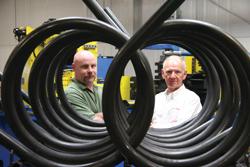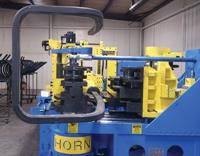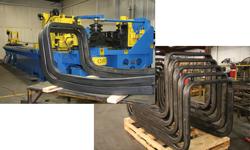- FMA
- The Fabricator
- FABTECH
- Canadian Metalworking
Categories
- Additive Manufacturing
- Aluminum Welding
- Arc Welding
- Assembly and Joining
- Automation and Robotics
- Bending and Forming
- Consumables
- Cutting and Weld Prep
- Electric Vehicles
- En Español
- Finishing
- Hydroforming
- Laser Cutting
- Laser Welding
- Machining
- Manufacturing Software
- Materials Handling
- Metals/Materials
- Oxyfuel Cutting
- Plasma Cutting
- Power Tools
- Punching and Other Holemaking
- Roll Forming
- Safety
- Sawing
- Shearing
- Shop Management
- Testing and Measuring
- Tube and Pipe Fabrication
- Tube and Pipe Production
- Waterjet Cutting
Industry Directory
Webcasts
Podcasts
FAB 40
Advertise
Subscribe
Account Login
Search
Fabricator reduces part handling, improves consistency with combination bender
Machine combines rotary, roll bending
- By Eric Lundin
- April 11, 2012
- Article
- Tube and Pipe Fabrication

Full Vision’s Sales and Engineering Manager Scott Marshall and General Manager Roger Ahrens demonstrate one of the capabilities of its latest investment, coiled tubing.
Elmer Stucky never intended to be a full-time fabricator. The founder of Full Vision Inc., Newton, Kan., was a farmer while the industry was undergoing a transformation. The internal combustion engine led to a wave of mechanization that modernized farming just as the Industrial Revolution had changed manufacturing. Tractors replaced animals, and implements such as cultivators, chisel plows, planters, spreaders, and combines replaced tools that had changed little since the dawn of time.
Despite the introduction of the modern tractor, one thing remained unchanged: Farmers still worked in open air. Machines didn’t have cabs, so farmers and farmhands were exposed to the elements just as they always had been. The dust thrown up by a combine during the harvest was a hazard. Fed up with the working conditions, Stucky designed and fabricated an enclosed cab that he attached onto his combine.
The idea caught on, and before long Stucky was moonlighting as a fabricator, making cabs for neighboring farmers. Named for the nearly uninterrupted, 360-degree view the cab provided, the Full Vision cab was a success. In 1958 Stucky incorporated Full Vision and began selling combine and tractor cabs to farm implement dealers in styles that fit many of the well-known combine and tractor manufacturers, such as John Deere, Massey Ferguson, International Harvester, Case, New Holland, and so on.
From Cabs to ROPS, FOPS
The idea of putting cabs on self-propelled equipment was so popular that eventually the OEMs began offering their own cabs, nearly squeezing the after-market cab manufacturers out of the market. This wasn’t a disaster, though; Full Vision found other markets, such as the construction industry, and began making cabs for sweepers, graders, and cranes. It also found a niche in aircraft tugs. A change in ownership in 1997, when the company was purchased by Peter and Patty Benson, brought yet another new product line, medical-grade treadmills.
Fabricating components for off-road equipment OEMs is still a major focus of the business. In addition to cabs, the company has expanded its capabilities to offer cab-related product lines, mainly roll-over protection systems (ROPS) and falling-object protective structures (FOPS). It also developed other lines of products and services—tubular structures, weldments, and contract manufacturing.
ROPS and FOPS, which have grown to become a mainstay of the business, are specialized items. They require more attention to detail in how they are engineered and manufactured the for industries such as lawn care, agriculture, construction, and transportation, and they must adhere to standards and regulations issued by several agencies—Occupational Safety and Health Administration (OSHA), Society of Automotive Engineers (SAE), International Organization for Standardization (ISO), American Society of Agricultural and Biological Engineers (ASABE), U.S. Dept. of Transportation (DOT), and the Organiza-tion for Economic Cooperation and Development (OECD). The raw materials, processes, and welders must be certified; each ROPS and FOPS must be traceable in case an accident leads to an investigation.
A Good Look Is Not as Easy as it Looks
Manufacturing a conventional ROPS or FOPS, characterized by straight lines and right angles, is one thing; manufacturing a modern one, an aesthetically pleasing structure designed with graceful bends and contours, is something else altogether. Over the years Full Vision had acquired all the equipment it needed, and then some—various machining centers, two flat sheet laser machines, two tubing laser machines (one with 2-D capability, the other with six-axis, 3-D capability), and a handful of benders to fabricate tube and pipe in sizes from ¾ in. to 8 in. OD—but it didn’t have the right equipment for making modern ROPS and FOPS efficiently.
“We used to use three machines for making a complex ROPS,” said Scott Marshall, Full Vision’s sales and engineering manager. The company used a ram bender to press the sweeping arc bend, then two rotary benders to make the easy-way and hard-way bends. The company found that it had too many handling steps.
“No customer wants to pay for non-value-added processes, so our customers aren’t willing to pay for us to move the parts from machine to machine,” said General Manager Roger Ahrens. This cumbersome process limited the company’s ability to make substantial progress in the market for ROPS and FOPS with sweeping bends and gentle arcs.
In addition, the company faced a limitation in the radiuses it could provide. Using conventional equipment, it needed a die for each radius.

A typical roll-over protection system (ROPS) component is made on Full Vision’s 5-in. bender. The machine makes all the bends needed for this part, rotary bends and roll bends in two planes. At the end of the bending cycle, the machine lowers the workpiece for ease of removal.
Combining Technologies
The company needed a bender upgrade. One option would be to buy a rotary draw bending machine with stacked tooling, allowing the company to make bends of several different radiuses on one setup. However, the long, sweeping bends would still require a trip to a second machine, so this wouldn’t eliminate part handling between bends, it would just reduce it. To be competitive, Full Vision needed bending and rolling capability on one machine. However, it had to proceed with caution to be sure it could justify the acquisition.
“Machines that can make high volumes of parts are easy to justify,” Ahrens said. “However, this isn’t the business we’re in. We’re primarily in the off-road industry, which includes equipment for agriculture, turf, construction, and others that fit that profile. We produce in low to medium volumes, primarily using rectangular and square tubing.”
The company purchased a 5-in. rotary/push bending machine with stacked tooling from Horn Machine Tool Inc. The stacked tooling allows more than one rotary draw bend per setup. This capability is handy for this application because most ROPS require both easy-way and hard-way bends. The push (roll) capability allows Full Vision to make large-radius bends on the same machine. And, because the rolling process uses bending rolls that can be adjusted to suit various radiuses, the company doesn’t have to purchase a separate die for each large-radius bend.
Because it’s a hybrid machine with high-output electric servo bending and push rolling, it provides speed and consistency the company doesn’t have with its other benders. This, combined with the improved consistency that comes with making all the bends in one continuous process on a single machine, reduced the amount of scrap the company generates.
“Using the old process, which required three machines, we’d often scrap the first one or two pieces at each machine until we got the machine dialed in,” Marshall said. “With one machine we expect to reduce our scrap by at least two-thirds, and we might even eliminate scrap.”
Consolidating all the bends into one machine also makes a more efficient use of time.
“The old system and the new system require two people, but making a ROPS on the new system takes less than half the time,” Marshall said. “Also, we have a significant reduction in setup time.”
The rotary/push bender wasn’t strictly a ROPS- and FOPS-related purchase.
“This is a strategic purchase,” Ahrens said, “We’re opening new avenues for our business so we can attract new customers and offer additional capabilities to our existing customers, allowing us to add some new looks and features to their products.”
“This is a game-changer for us,” Marshall said.
About the Author

Eric Lundin
2135 Point Blvd
Elgin, IL 60123
815-227-8262
Eric Lundin worked on The Tube & Pipe Journal from 2000 to 2022.
About the Publication
Related Companies
subscribe now

The Tube and Pipe Journal became the first magazine dedicated to serving the metal tube and pipe industry in 1990. Today, it remains the only North American publication devoted to this industry, and it has become the most trusted source of information for tube and pipe professionals.
start your free subscription- Stay connected from anywhere

Easily access valuable industry resources now with full access to the digital edition of The Fabricator.

Easily access valuable industry resources now with full access to the digital edition of The Welder.

Easily access valuable industry resources now with full access to the digital edition of The Tube and Pipe Journal.
- Podcasting
- Podcast:
- The Fabricator Podcast
- Published:
- 04/16/2024
- Running Time:
- 63:29
In this episode of The Fabricator Podcast, Caleb Chamberlain, co-founder and CEO of OSH Cut, discusses his company’s...
- Trending Articles
Team Industries names director of advanced technology and manufacturing

Orbital tube welding webinar to be held April 23

3D laser tube cutting system available in 3, 4, or 5 kW

Corrosion-inhibiting coating can be peeled off after use

Brushless copper tubing cutter adjusts to ODs up to 2-1/8 in.

- Industry Events
16th Annual Safety Conference
- April 30 - May 1, 2024
- Elgin,
Pipe and Tube Conference
- May 21 - 22, 2024
- Omaha, NE
World-Class Roll Forming Workshop
- June 5 - 6, 2024
- Louisville, KY
Advanced Laser Application Workshop
- June 25 - 27, 2024
- Novi, MI



























